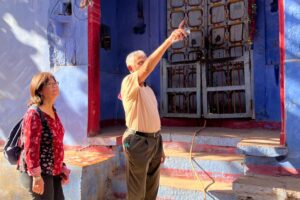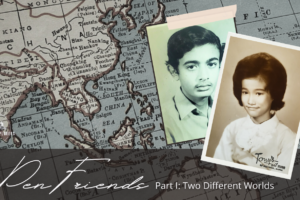For quite some time, we’ve dreamed of traveling to the Galapagos islands, home to fascinating and unique animals– animals that Charles Darwin observed to write a chunk of On the Origin of Species.
In 2020, we were looking for that region and came across a country called Ecuador. And while looking around places there, we saw that Galapagos was just 1000 kilometers from the main coast. We then flew from mainland Ecuador to Santa Cruz, Galapagos’ main island.

The Islands
Upon arriving, we learned the most interesting fact about its pristine blue waters. The area is so highly protected that they thoroughly screen bags at the airport so that no foreign substances would come in and impact the wildlife and ecosystem.
Traveling to the Galapagos Islands, we took a boat with 100 people. We spent eight days there and visited about eight different islands. During the day, we would go on excursions to different places, come back for lunch, and explore some more in the afternoon. We stayed on the coastline of some islands and went hiking and walking on others. In the evenings, we would go back to the boat and rest for the night.
Some boat rides were long. One day, it tools about 35 to 45 minutes to reach the islands. But most of the time, it would just be 15 minutes. Even so, that’s still quite far from human intervention, so the species grow in their natural environment.
As the days progressed, we went sightseeing some more. We thought we’d see lush and green forests. On the contrary, we were met with a lot of very dry areas, rocks, and dull trees. There were, however, different kinds of sand: white, red, and black.

The Animals
Interestingly, we came at the season when seals had their babies, some of which were absolutely born within hours before we saw them. It was fascinating to see these little pups, particularly the interaction between their mothers.
We also watched them just having fun. Both older and younger ones played in what looked like swimming pools, but there were just multiple areas of water between rocks. The seals were swimming, jumping, and simply enjoying the water.

We observed a newborn seal pup very curious about a crab. The baby seal tried to follow the crab, but it kept backing away.
We’ve always been intrigued by scenarios like that because of the concept of “survival of the fittest” and its essence in how you add to the environment. That is the secret to success most of the time– you survive and thrive. Seeing that first-hand was something else.
A compelling moment also happened between hawks. After a seal had a baby, its placenta was left on the ground. Then a hawk came and started eating it. A second one landed after a while but didn’t join the first hawk. It had a “hawkish” manner– waiting and not intervening until the first one finished. When the first was done eating, it turned to the second to sort of signal it was its turn to eat.
On the beaches, we saw an array of birds, from flamingos to the various boobies– blue-footed, red-footed, and Nazca. Their beaks and feet were fascinating to see.

You’d think humans were the only territorial ones, but animals are too. On our last day, we went up the hills of San Cristobal. Along the way, we spotted a tortoise that started up the hill and was going down to lay eggs. When another tortoise came close, they gave each other “messages” to just back off.
Here’s one more riveting story about animals the tour guide told us. Some male iguanas pretend to be female to get out of getting food or hunting. And when the group came back, the “female” iguanas hid so the others won’t suspect them. He added that even in the animal kingdom, things like this happen. When males would go out to do so, the ones acting would trick the others and just stay behind so that they can “party” with other female iguanas.

Wildlife Protection
Another peculiar thing about the islands was that there were no bathrooms. If you’re looking for Galapagos islands travel tips, here’s one: better be sure you’re prepared to hold it in for two to three hours while you hike and walk around. It was tough, but we’re amazed we could do that.
Some people, on the other hand, weren’t as capable. So, if you do need to go, you’ll either have to do it in the ocean (number one only) or go back to the boat (particularly for number two).
You might be wondering about the lack of toilets on the islands. Well, it’s to protect the wildlife from germs in your excrement. The animals are not used to humans, so bacteria from our wastes can disturb the ecosystem and even eliminate species from the island. The Galapagos has a lot of unique species, some not seen anywhere else in the world. So, it’s a strictly protected area.
We also learned that the people caring for the animals on a specific island don’t interfere with them. For example, if an animal were to kill another, they would just let it happen. It’s survival of the fittest again, the way nature intended, and why the people don’t get involved.

The Rivalries In The Galapagos
The guy told us another compelling story about the Galapagos, this time about humans. In the beginning, only one family arrived in the region. Soon, another came along, but the two parties did not get along. It was so intense that they would basically hurt each other, even have games to do it.

One of the ladies from the second family even tried to get the attention or seduce one of the men from the original family.
It’s actually quite funny that these two families fought when there was so much land between and around them. One stayed on one side of the island, the other on the other side. But they still fought. Again, survival of the fittest.
It almost seems like the humans are wilder than the animals. But as I said, I saw how territorial the tortoise could be. I did not see the iguanas fighting. The ones on land were more isolated, quite far from each other. Contrarily, marine iguanas were pretty close to each other.
You can watch a whole documentary on these events and more: The Galapagos Affair: Satan Came To Eden. (Not on Netflix, but Apple+)

Out of all the animals we encountered in the Galapagos Islands, we think the Nazca booby and iguanas represented us best– or were our favorites, at least.
We preferred the Nazca booby over the red-footed and blue-footed ones, but we do think they look elegant with their black beaks. As for the iguanas, they look scary, just stuck on the beach, almost alien- or dinosaur-like.
We thoroughly enjoyed our adventures in the Galapagos Islands! We’re giving an extra special thanks to Adventure Life – our knowledgable tour guide company. From learning about wildlife protection to seeing how they act first-hand, there’s so much to see and do there. And if you enjoyed reading about this trip, stay tuned for more of our adventures!



